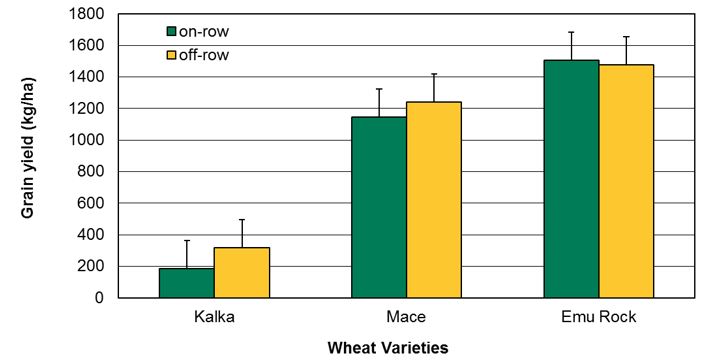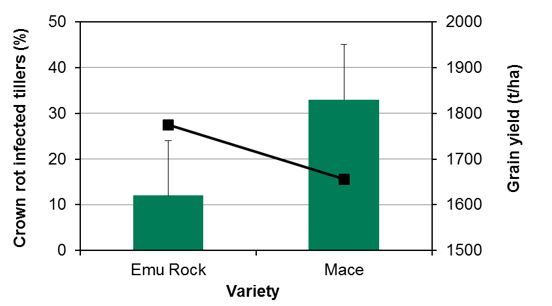Reduce losses from crown rot through variety choice and inter-row sowing
Author: Shahajahan Miyan, Daniel Hüberli, Miriam Connor, Kris Gajda and Bill MacLeod, Department of Agriculture and Food Western Australia | Date: 24 Feb 2015
Key messages
- In field trials, crown rot incidence was often lower and grain yield higher in the wheat variety Emu Rock compared with the variety Mace and the durum wheat variety Kalka.
- An advantage (up to 11% reduction in crown rot infected main tillers) is gained from sowing “off-row” (between the previous season’s rows of wheat stubble) compared to sowing “on-row” (directly into the previous season’s wheat rows).
Aims
To compare the management options for crown rot control through variety choice and inter-row sowing for grain yield and grain quality.
Method
Small Plot Trial
A field trial comparing wheat varieties and inter-row sowing was conducted on a farm at Salmon Gums in 2012. Two bread wheat varieties (Mace: crown rot susceptible and Emu Rock: less susceptible to crown rot) and one durum wheat variety (Kalka: crown rot susceptible) were sown on 11 June 2012 with a target plant density of 150 plants/m2. The sowing was done on and off the previous year’s rows of wheat stubble. Each plot was 40m long and 1.44m wide. Soil samples were collected, prior to seeding to 10cm depth, and tested using PreDicta-B (SARDI, Adelaide); then categorised as low, medium and high crown rot disease risk against standard levels. Plant establishment counts were recorded by counting plant numbers in two 1m rows in each plot at three locations. A total of 40 plants were collected at anthesis from each plot to determine the percent main tillers with basal browning (infected main tillers). The number of white heads was estimated only for Mace and Kalka by counting white head numbers in two 1m rows in each plot at ten locations; Emu Rock had already hayed off at the time of assessment so white heads could not be determined. The trial was harvested with a small plot header and a sub-sample was taken for grain quality analysis.
Large Scale Farmer's Trial
Based on 2012 results from a small plot trial, a large scale demonstration trial was conducted in 2014 at a farm in Lake Grace. The paddock was selected based on the previous years' crown rot infection history and having a high inoculum level in the soil as determined by PreDicta-B. Mace and Emu Rock were each sown on-row and off-row on 21 May 2014 with a target plant density of 150m2. The unit plot size was 100m long and 18m wide with three replications. The same measurements were collected as described above and the trial was managed and harvested by the farmer.
Data on infected main tillers, white heads, grain yield, grain protein and screenings were recorded and analysis of variance was carried out using Genstat 16th edition.
Results
Small Plot Trial
The 2012 growing season rainfall at Salmon Gums from April to October was 124.5mm. Crop establishment was good, but low rainfall in September and October led to reduced grain yield.
Wheat varieties had a significant effect on the percent crown rot infection of tillers. Infection of tillers was the highest in the susceptible durum variety Kalka and the lowest in the less susceptible Emu Rock (Figure 1). Sowing off-row significantly reduced the infected tillers by 11 and 16% compared to sowing on-row for Mace and Kalka, respectively (Figure 1).

Figure 1. Average of crown rot infected main tillers in three wheat varieties sown on-row or off-row. Vertical bars are least significant difference (lsd).
The expression of white heads is driven by moisture stress during grain fill and results in reduced grain yield. Mace had significantly fewer white heads than Kalka; Emu Rock was not assessed due to variety having hayed off at assessment. There was no interaction effect between variety and inter-row sowing.
Emu Rock produced 285kg ($83/ha at $290/t) and 1209kg more grain than Mace and Kalka, respectively, and these interactions were significant (Figure 2). Inter-row sowing and the interaction between inter-row sowing and wheat varieties were not significant for grain yield.

Figure 2. Mean grain yield for three wheat varieties sown on and off the previous year’s wheat row. Vertical bars are least significant difference (lsd).
Yield of plots which were grown on low, medium or high levels of initial inoculum present in the paddock were analysed and there was a significant difference on grain yield due to different inoculum levels at sowing. High levels of crown rot inoculum (as categorised by PreDicta-B) significantly reduced the grain yield by 153kg/ha compared to low levels. There was no difference in grain yield between low and medium inoculum levels.
Protein content was significantly different among wheat varieties. The highest protein content was observed in Kalka durum wheat. However, no varieties achieved 13% protein to attract premium price. The highest screenings were recorded in durum wheat compared to both bread wheats due to the high number of white heads. There was no difference between Mace and Emu Rock in screenings. However, bread wheat screenings were below the 5% standard for receival (data not shown).
Large Scale Farmer's Trial
The 2014 growing season rainfall at Lake Grace from April to October was 319mm, however, little rainfall was recorded in June (18mm). Plant densities were over 100m2 which is in the yield target of 2t/ha.
There was a significant effect of wheat varieties on the number of crown rot infected main tillers in this trial site. Mace had significantly higher infected main tillers (33%) than Emu Rock (12%) (Figure 3). But there was no significant difference in infected main tillers between on-row and off-row sowing.

Figure 3. Average incidence of crown rot infected main tillers (green bars) and grain yield (line) for two wheat varieties at Lake Grace. Vertical bars are least significant difference (lsd) for crown rot incidence.
The number of white heads was significantly different between wheat varieties. Mace produced the highest white heads (42 white head/m2) while Emu Rock had the lowest (22 white heads/m2). There was also a significant reduction with off-row sowing compared to on-row sowing by13 white heads/m2. Infection of tillers translates into white heads as a consequence of stress during early grain filling and differs between varieties depending on their tolerance of water stress and the stage of maturity.
Emu Rock produced 118kg/ha ($33/ha at $280/t) more grain than Mace (Figure 3), but this was not significant. A similar trend was recorded for inter-sowing with off-row sowing adding 56 kg ($16/ha at $280/t) and 123 kg ($34/ha at $280/t) extra to on-row sowing for Mace and Emu Rock, respectively.
Conclusion
- Emu Rock has an advantage over Mace as it suffered less crown rot infection and produced higher grain yield where crown rot was present.
- A small advantage is gained from off-row sowing compared to on-row sowing to reduce crown rot infection and thus improve grain yield.
- In paddocks with a significant crown rot history, growers should consider growing a non-cereal break crop to reduce the inoculum level for subsequent wheat crops.
Acknowledgments
GRDC for funding the research. DAFWA Esperance Research Support Unit for seeding and harvesting trials. All the growers that kindly allowed DAFWA to conduct the trials on their land during 2012 and 2014.
Was this page helpful?
YOUR FEEDBACK
